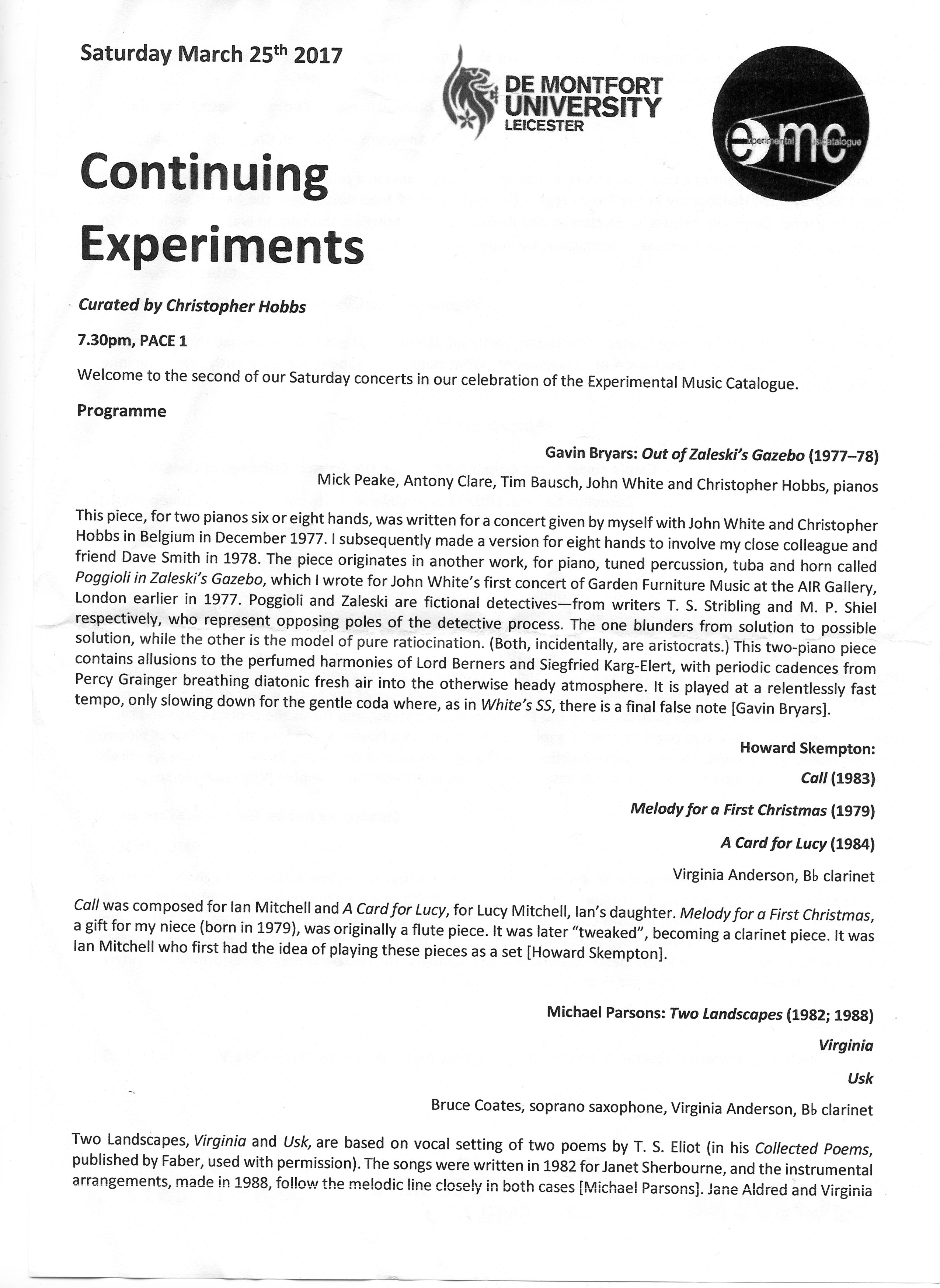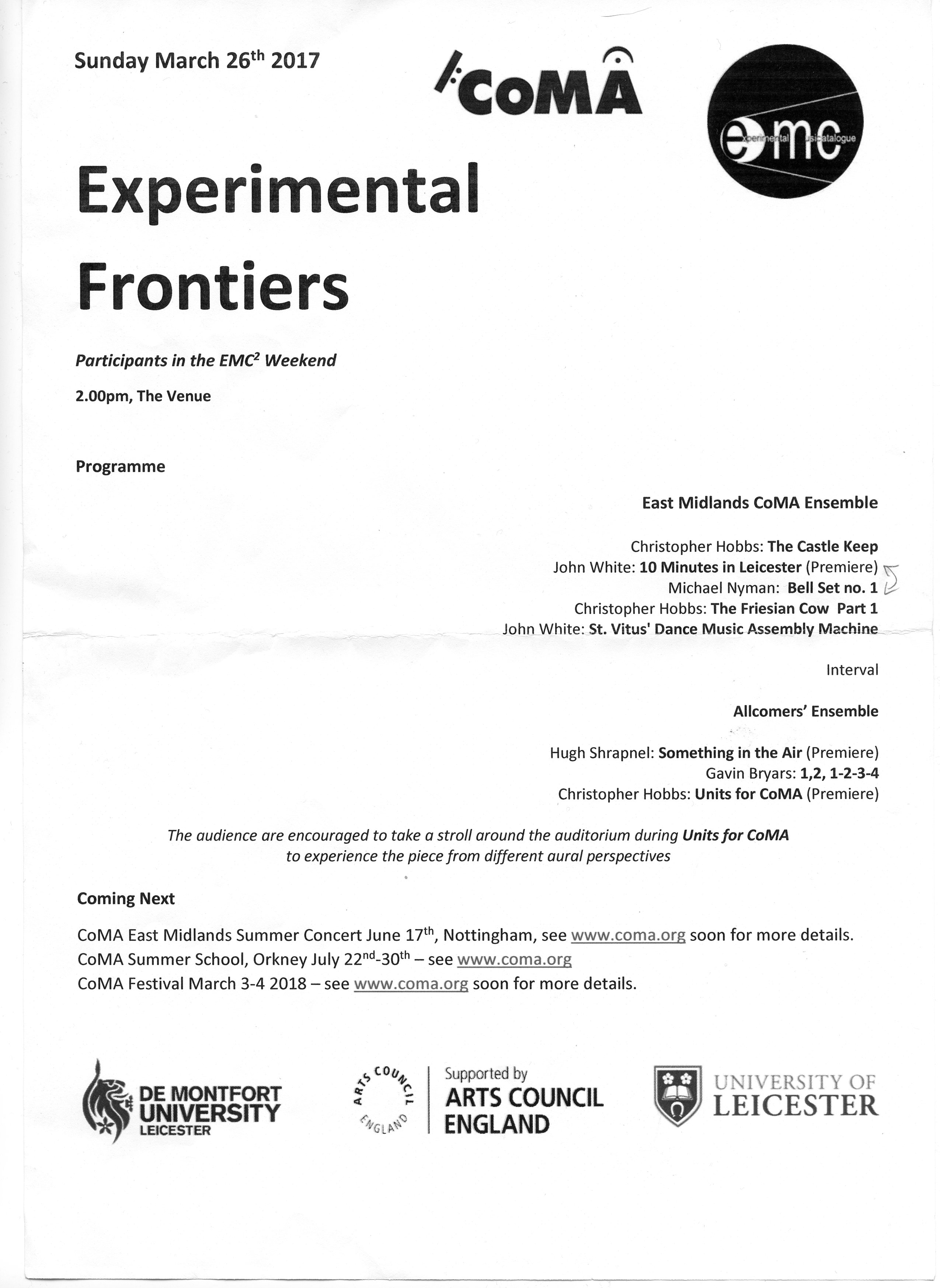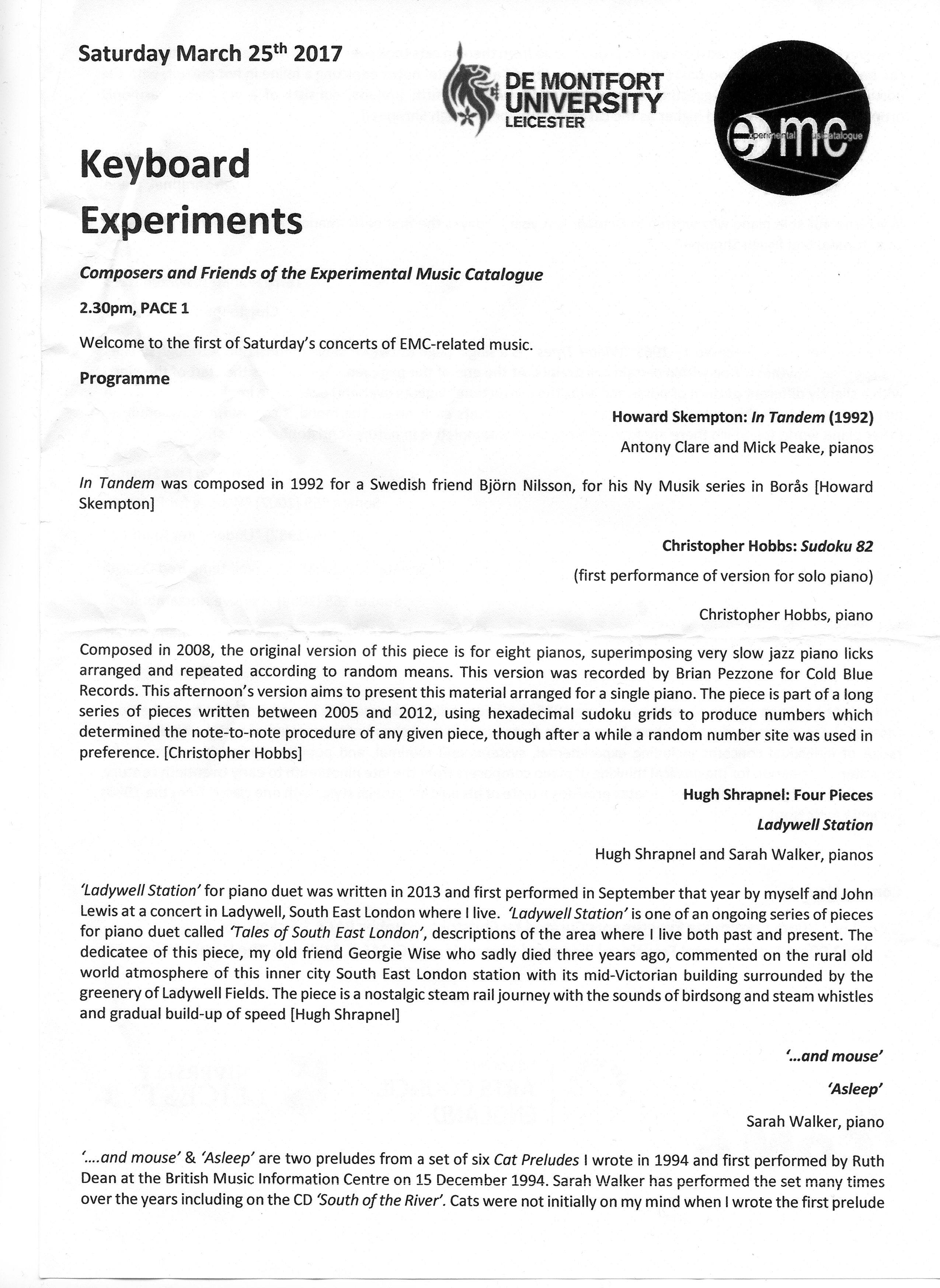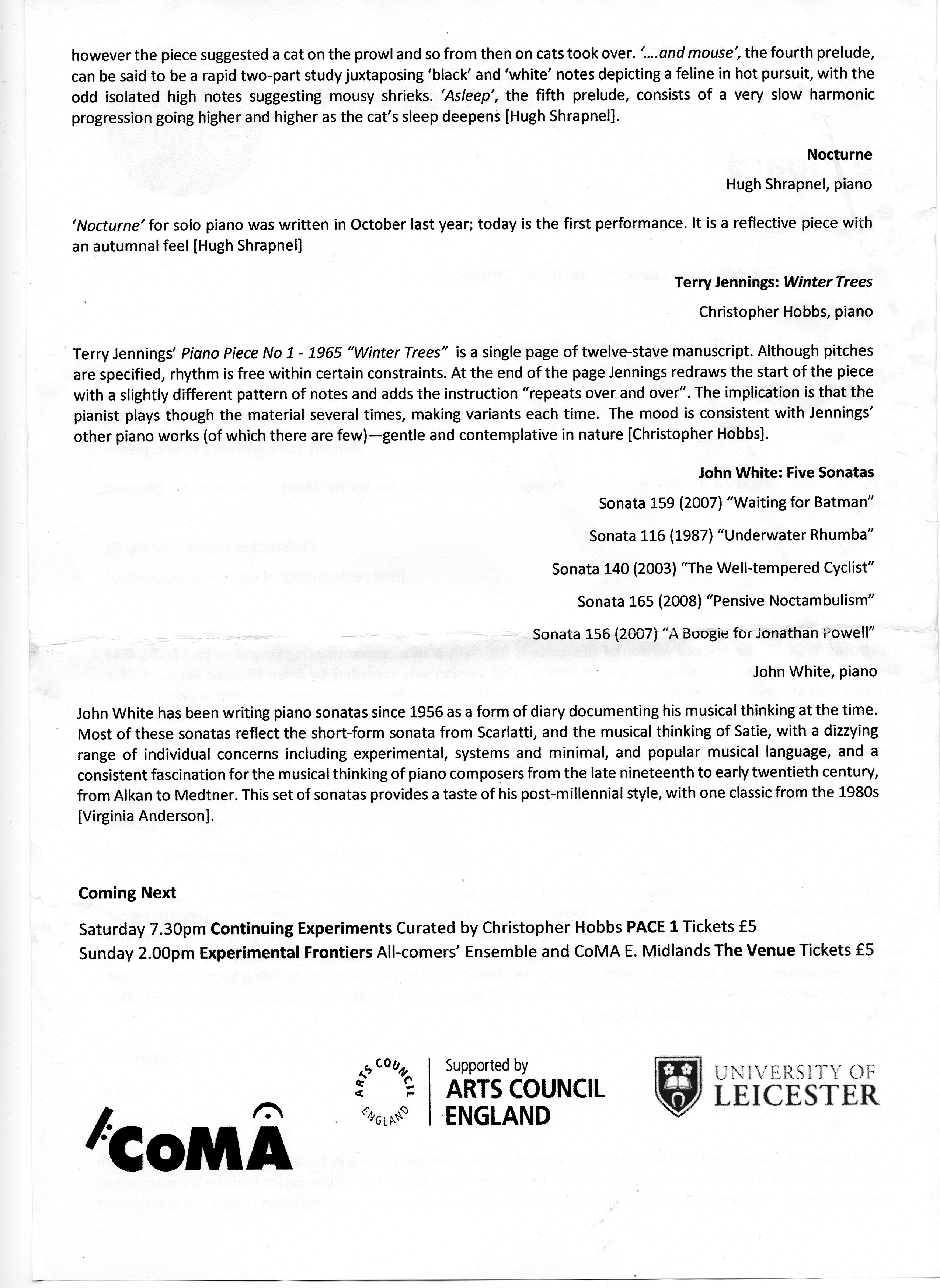This is turning into a Christopher Hobbs spring: Second Doomsday Machine is on a set, Infernal Machines, with Julius Eastman’s Evil Nigger, and some guy named Arnold Schoenberg’s Pierrot Lunaire (oh, yeah—him!), on Occupy the Pianos, at St John’s Smith Square. Saturday 6 May. The whole day (with loads of goodies by Ives, Nancarrow, J.L. Adams and more) begins at 11.00 (for the great price of £15!); Infernal Machines starts at 7 pm. https://www.sjss.org.uk/events/occupy-pianos
The EMC Blog
Hay-on-Wye Festival
Hobbs in Hay-on-Wye! Literary music for Britain’s literature capital!
Sara Stowe and Chris Brannick (pictured above) are performing new music for voice and percussion as part of the Hay Music series, at St Mary’s Church, Hay-on-Wye, Saturday 22 April, at 7 pm. Included will be a brand new premiere by Chris Hobbs, Three Views of Anna, with texts from James Joyce, Finnegans Wake.
To be there, rather than being square, tickets and info here:
https://tickets.boothbooks.co.uk/p-2118-hay-music-chris-brannick-and-sara-stowe.aspx
EMC2 Programmes, pt. 2
The EMC² Weekend at De Montfort University, Leicester, was a great success, with talks, concerts, and a chance for all to perform great music in the tradition of the Experimental Music Catalogue. This weekend was the brainchild of Kieran O’Riordan, with Anna Claydon of CoMA (Contemporary Music for All), and performed with energy and much skill by the members of East Midlands CoMA, the improvisation groups CHA (Bruce Coates, Chris Hobbs, Virginia Anderson) and the South Leicestershire Improvisors Ensemble (Lee Allatson, Rick Nance, Virginia Anderson, Bruce Coates and Chris Hobbs), guest expert composers and performers including John White, Hugh Shrapnel, Sarah Walker, Chris Hobbs, Virginia Anderson, and Bruce Coates. Papers were given on related subjects from Virginia Anderson, Hilary Bracefield and Tim Bausch. Much material has been created from this event; much needs to be sifted, edited, and collated for publication. The highlights of Friday and daytime Saturday appear in the previous post. But we would like to share a little more of the event as it went on:
Saturday, 25 March:
At 7.30 pm, came the second concert, Continuing Experiments:
Not all of these pieces are available yet on video, but here are two from the second half:
First, Carole Finer, Magic Carpet, and Cornelius Cardew, “Little Flower of the North” (from Schooltime Compositions), performed by the South Leicestershire Improvisors Ensemble (Lee Allatson, drums, Virginia Anderson, clarinets, Bruce Coates, saxes, Chris Hobbs, piano, Rick Nance Tibetan bowl and other instruments).
Then Christopher Hobbs, The Friesian Cow, part 2, performed by members of SLIE and the EMC All*Stars (including John Richards, electronics, and John White, helicon):
Sunday, 26 March:
After a welcome and rehearsals in the morning, there was the Experimental Frontiers concert, consisting of performers from all the events through the weekend.
This is the first half:
Публикувахте от Experimental Music Catalogue в Неделя, 26 март 2017 г.
and the second half, which includes a video greeting from former EMC committee chair, Gavin Bryars, which wrapped up the approach and ethos for the festival, as Virginia Anderson’s talk began it.
Публикувахте от Experimental Music Catalogue в Неделя, 26 март 2017 г.
Thanks to Kieran O’Riordan, Anna Claydon for putting the EMC² Festival on; to James Thompson and his team of technicians at DMU for fantastic lighting and sound (check out the final piece, Chris Hobbs’ CoMA Units, for an example of their work); to Rui and Conner at the University of Leicester for their roving and fixed video work; and to Lee Allatson for HD video on Saturday night. And, of course CoMA, and everyone who took part. It was an amazing weekend.
EMC2 Programmes
The EMC² Weekend at De Montfort University, Leicester, was a great success, with talks, concerts, and a chance for all to perform great music in the tradition of the Experimental Music Catalogue. This weekend was the brainchild of Kieran O’Riordan, with Anna Claydon of CoMA (Contemporary Music for All), and performed with energy and much skill by the members of East Midlands CoMA, the improvisation groups CHA (Bruce Coates, Chris Hobbs, Virginia Anderson) and the South Leicestershire Improvisors Ensemble (Lee Allatson, Rick Nance, Virginia Anderson, Bruce Coates and Chris Hobbs), guest expert composers and performers including John White, Hugh Shrapnel, Sarah Walker, Chris Hobbs, Virginia Anderson, and Bruce Coates. Papers were given on related subjects from Virginia Anderson, Hilary Bracefield and Tim Bausch. Much material has been created from this event; much needs to be sifted, edited, and collated for publication. But we would like to share a little taste of the event as it went on:
Friday, 24 March:
Schedule:
Session 1: Setting the Scene
1.45 pm: Virginia Anderson, “The Experimental Music Catalogue: Past, Present, and Future”
Recording of live feed:
The Experimental Music Catalogue
Публикувахте от LUST в Петък, 24 март 2017 г.
Rehearsals and tea, then
4.45pm: Hilary Bracefield, “From Birmingham to Belfast: Improvising and experimenting with students”
(talk notes above for abstract and bio)
Recording of live feed:
Hilary Bracefield, ‘From Birmingham to Belfast: improvising and experimenting with students’
Публикувахте от Experimental Music Catalogue в Петък, 24 март 2017 г.
Evening concert, MTI Goes EMC²: Students and staff from DMU’s music technology department play music.
Saturday, 25 March:
Began with rehearsals for allcomers and tea, then lunch, then:
1.30 pm: Panel chaired by Sarah Walker, including Virginia Anderson, Chris Hobbs, John White and Hugh Shrapnel
Recording of live feed:
Panel Chaired by Sarah Walker, including Virginia Anderson, Chris Hobbs, John White and Hugh Shrapnel.
Публикувахте от Experimental Music Catalogue в Събота, 25 март 2017 г.
2.30: Concert 2: Keyboard Experiments
Programme:
Video awaiting processing, so we’ll have to wait for good quality clips, and for Howard Skempton’s In Tandem, performed by Antony Clare and Mick Peake.
However here are links to very short clips:
Chris Hobbs, premiere of solo version of Sudoku 82:
We're hoping to bring you not only the talking portion of the EMC2 weekend, but also audio and perhaps video records of these historic concerts. In the meantime, here are a few clips from the lunchtime Keyboard Experiments concert: first, a few seconds of Chris Hobbs, premiering the first solo version of his Cold Blue Sudoku 82.
Публикувахте от Experimental Music Catalogue в Неделя, 26 март 2017 г.
Hugh Shrapnel and Sarah Walker, playing Hugh Shrapnel, Ladywell Station
We're hoping to bring you not only the talking portion of the EMC2 weekend, but also audio and perhaps video records of these historic concerts. In the meantime, here are a few clips from the lunchtime Keyboard Experiments concert: Here is Hugh Shrapnel and Sarah Walker performing Hugh's Ladywell Station.
Публикувахте от Experimental Music Catalogue в Неделя, 26 март 2017 г.
Hugh Shrapnel, Cat Preludes, “…and mouse”, performed by Sarah Walker:
We're hoping to bring you not only the talking portion of the EMC2 weekend, but also audio and perhaps video records of these historic concerts. In the meantime, here are a few clips from the lunchtime Keyboard Experiments concert: Sarah Walker playing "…and mouse" from Hugh Shrapnel's Cat Preludes.
Публикувахте от Experimental Music Catalogue в Неделя, 26 март 2017 г.
Also “Asleep”, from Cat Preludes
Here is Shrapnel playing his Nocturne:
We're hoping to bring you not only the talking portion of the EMC2 weekend, but also audio and perhaps video records of these historic concerts. In the meantime, here are a few clips from the lunchtime Keyboard Experiments concert: Hugh Shrapnel playing his Nocturne.
Публикувахте от Experimental Music Catalogue в Неделя, 26 март 2017 г.
Chris Hobbs, with Terry Jennings’ Winter Trees:
We're hoping to bring you not only the talking portion of the EMC2 weekend, but also audio and perhaps video records of these historic concerts. In the meantime, here are a few clips from the lunchtime Keyboard Experiments concert: Chris Hobbs performing Terry Jennings' Winter Trees.
Публикувахте от Experimental Music Catalogue в Неделя, 26 март 2017 г.
and John White, here playing most of Sonata 159, “Waiting for Batman”:
We're hoping to bring you not only the talking portion of the EMC2 weekend, but also audio and perhaps video records of these historic concerts. In the meantime, here are a few clips from the lunchtime Keyboard Experiments concert: John White performing his 2007 Piano Sonata 159, "Waiting for Batman".
Публикувахте от Experimental Music Catalogue в Неделя, 26 март 2017 г.
At 5 pm (after more rehearsals), Tim Bausch gave a paper, “Repetition as Catalyst: The Process of Creation in the Music of Alvin Lucier.”
Tim Bausch, ‘Repetition as Catalyst: The Process of Creation in the Music of Alvin Lucier’
Публикувахте от Experimental Music Catalogue в Събота, 25 март 2017 г.
We will get to the evening concert, Continuing Experiments, in another post.
Sunday in Leicester with the EMC
Sunday afternoon, 26 March, on the EMC² Festival, is shaping up very well indeed. Included will be a new work by John White: “Ten Minutes in Leicester”. And a new commission from Hugh Shrapnel: “Something’s in the Air”. Plus Michael Nyman’s Bell Set No. 1 and Gavin Bryars’ classic piece “1, 2, 1-2-3-4”. Here’s more about it from Gavin Bryars:
My piece starts with the bandleader saying “1, 2, 1-2-3-4”, and at that moment everyone presses the start button on a cassette recorder. Each cassette recorder has a copy of the same recording that is listened to on headphones, and each player “shadows” his own instrument trying to play exactly the part played by his own instrument. The recording was not multi-copied – each was done separately, so the first sound after the leader tape was not in exactly the same place on each cassette. At that time too, 1971, portable cassette machines were not particularly accurate – running speeds could fluctuate and batteries would run down. No one reproduces the song itself: everyone just plays the accompaniment.
It’s an example of “private music” – a kind of philosophical concept that informed a number of my pieces at that time. Here, each individual player hears the music on the headphones as well as his own playing (but not that of the other players); the audience hears everyone’s live music (but not the music on the headphones); and nobody has access to everything.
Plus CoMA Units, a new commission from Christopher Hobbs. About the piece:
Units for CoMA was composed for [Sunday’s] concert. The performers divide themselves into various units (battery, air, wind, string, vocal) and the (quite unspecific) instructions are intended to allow them to freely research, devise and explore the nature of their respective units, either in solo or in group realization. The inspiration for the piece comes from the “battery unit” of percussionists in the final movement of Charles Ives’ Fourth Symphony, who provide a constant background to the rest of the orchestra, while remaining independent of it.
Also by Hobbs, The Castle Keep and part 1 of The Friesian Cow (part 2 is being played on Saturday night).
All in all, this is shaping up to be the festival of the year for experimental music fans, if not festival of the decade. Contacts to know more, be there, or be square (available on our welcome page as well):
For information on how to attend and book (though the information on the programme right now—17 March—is months old), see the CoMA website: http://www.coma.org/whats-on/events/emc²/ CoMA East Midlands has a Facebook page, with occasional news: https://www.facebook.com/groups/105499836160596/
For some idea of the schedule, see our Blog. Two posts already deal with its progress: EMC2: On the way! and the update: EMC2: Remembering the Experimental Music Catalogue (schedule) . We will try to put up information, as we hear of them, as blog announcements.
And for the De Montfort link on Facebook, see their page: DMU Music Facebook page
Events keep developing: we’ll keep you informed, here on our home page, on our blog, and on our Facebook page.
Practice Diary for EMC2, pt. 1
Just as I posted a practice diary for Cornelius Cardew’s The Great Learning in two parts when we performed it in London in 2015, I thought I’d write down some musings about a set I am playing for the “Continuing Experiments” concert in the EMC²: Remembering the Experimental Music Catalogue weekend at De Montfort University, on 25 March (the whole festival runs from 24–26 March). My set includes pieces by Howard Skempton and Michael Parsons, and just as my diary for The Great Learning showed that indeterminate music using text notation took care and preparation, I hope to show that the so-called “New Simplicity” is not so very simple. In fact, this music demands what I have called elsewhere “virtuoso in miniature.”
I have been working some weeks on these pieces, which include Call (1983), Melody for a First Christmas (1979), and A Card for Lucy (1984)—all by Howard Skempton— and Two Landscapes (1982; 1988) and Kucinata (1988) by Michael Parsons. All of the Skempton pieces are for solo instrument; Two Landscapes was written in its 1988 version for two clarinets (but is being played as a duo for soprano saxophone and B-flat clarinet), and Kucinata is for clarinet and drum. This Monday I rehearsed Two Landscapes with the saxophonist Bruce Coates and last night Chris Hobbs and I obtained a bata drum for Kucinata (kindly lent by Lee Allatson, who runs the Dye House Drum Works in Leicester). Thus this first diary entry finds us well along the way toward performance.
The issues that arise in playing this music are specific to each piece, and in this entry I shall deal with a description of the first piece and its challenges. Call consists of a number of phrased events ending with fermatas and separated by one-beat rests with fermatas. Many of the events are repeated—eight different events, followed by a repeat of the first seven, with an extended version of the eighth, and concluding with even events of related, though mainly different, material. The dynamic is piano throughout with a musical instruction of “gently flowing”. The events are all primarily disjunct, mainly arpeggiated. There is no tempo marking.
I asked Howard Skempton about the tempo on all three of these pieces. I had thought that, though it was an excellent performance, John Corbett’s tempo on Call (on the album Surface Tension, Mode Records Mode 61, 1998) was slower than I would like. The composer’s answer was simultaneously helpful (in that it was clear) and unhelpful (in that it did not provide a solution): “There is no fixed tempo. If I’m ever asked about tempo, I always say that the right tempo is the tempo that allows for the possibility of rubato. Which doesn’t mean that I’m encouraging the use of rubato. I’m just welcoming it where it seems natural. And it will seem natural if the tempo is right.” Thus I had to find the tempo and durations of the pauses for myself.
The solution essentially is to study, play and think. The title, Call, originally suggested to me a kind of trumpet or bugle call, or perhaps something like the “Scène aux champs” of Hector Berlioz’s Symphonie fantastique, in which shepherds, represented by a cor anglais and offstage oboe trade melodic calls (ranz des vaches) in the evening at some distance. Skempton’s Call certainly has the flavour of the crepuscular: of taps, perhaps. But then I was listening one early morning to birdsong, just after the dawn chorus had died away. In particular, the blackbirds shaped their calls of motives separated by short pauses. Each repetition was exactly, or almost exactly the same; the motives varied before a repetition would begin. This turned the idea of the crepuscular call into a new area for me: instead of the military or lonely shepherds, the call was birdsong; the twilight was dawn, not dusk; and the musical sound world, although remaining clearly in Skempton-land, tilted away from Berlioz and closer to the territory of Olivier Messiaen.
This dramatic “note” on which to approach the piece gives me a way into the restraint that Skempton’s music always needs, and the tenderness that commonly exists in the pieces. Like the blackbird, I could state the repeated motives almost exactly the same way each time (though I am already stepping away from a literal repetition as I understand the piece’s semantics), while I can work the emotional content into the new material, which, beginning a little past the two-thirds mark of the piece, acts as a kind of conclusion to the piece’s “argument”. The first event that really concerned me was the third one, a set of quaver and semiquaver triplets. These cannot be played in any other way than as swung, jazzy quavers. Philip Clarke, in Gramophone, focuses on this event:
Carefully placed around Call’s largely open-ended, downriver rhythmic currents is a motif knitted together from “swung” quavers, which right away evokes Benny Goodman and Artie Shaw, and reminds you how often English composers of a certain generation and aesthetic persuasion, writing their generic fast-slow-fast wind concertos and sonatas, try to sex up their pallid rhythmic oom-pahs with a jazzy shot in the arm.
Skempton – clever him – manages to have it both ways, though. That momentary sense of swing is like a wry slap on the wrist, delivered entirely without rancour or hectoring, towards such transatlantic tendencies. But he also wants listeners to derive pleasure from those peaks of rhythmic exhilaration, and so gives them prominence in the structure like a punctuating semi-quote, a knowing reference to material from outside his orbit. You hear, you enjoy, and then think about how more cavalier composers freeload off the gestural surface of jazz. [http://www.moderecords.com/catalog/061skempton.html]
As much as Clarke likes Skempton, I cannot see how his description tallies with my experience of Call. The swung-quaver event could sound like parody jazz and that approach would knock the piece right out of its soundworld. Yet to try to work against the jazz reference is pointless. Here the even-handed performance of the blackbird provides a guide. When I first moved to my present house, we had a blackbird resident in our garden that Chris Hobbs and I called the “St Louis Blues Bird”. Like all blackbirds, this blackbird had a wide repertoire of short songs, one of which sounded exactly like the opening four notes of “St. Louis Blues” in exactly the right rhythm and nearly the right pitches, although the last note of was more of a croak than a pitch. This bird sang his blues call in the exactly way—within the same dynamic range and the same shape—that he sang his other calls, only with proper swung rhythm.
I am therefore working to play these calls within a consistent character throughout. Not that they will be identical, as there is a progression of argument, a passage of time and thought that moves through the piece as a whole. But the swung quavers, still carrying its “jazz” signifiers in the shape of its notes and durations, are to be played using the same calm, considered rhetoric of the other, non-jazzy, events. And this is what I mean by “virtuosity in miniature”: with Skempton, you are out on the tightrope. Having so few notes, there is no way to fudge or elide or hide errors. If I rise to an altissimo note (which happens in many of the events) and squeak or hit a harmonic, if I don’t slip smoothly from one note to the next without a break, I might as well wear clown pants and drop them at that moment. A scary thought, indeed.
This diary will continue as I have time to write it.
EMC2: Remembering the Experimental Music Catalogue (schedule)
Hi, everyone:
Here’s the revised schedule for the concerts for EMC²: Remembering the Experimental Music Catalogue. The new version includes some of Terry Jennings’ pieces from the EMC Keyboard Anthology. If you like English experimental, systems, minimal and postminimal music, this is THE weekend!
yrs,
admin…..
Friday, 24 March:
- Welcome
- Virginia Anderson, The Experimental Music Catalogue: Past, Present, and Future [an introduction to the EMC, its original incarnation as a publishing project, its resurrection in 1999 as a website, and its current work in pdf, Bandcamp recordings, and Facebook page]
- Hilary Bracefield, From Birmingham to Belfast: Improvising and experimenting with students [Bracefield, the co-founder of the new music magazine Contact, on university groups]
- There will be rehearsals for CoMA members and an all-comers group throughout the day, including music by Christopher Hobbs, Hugh Shrapnel, and Gavin Bryars. The evening concert will be provided by DMU staff and students.
Saturday, 25 March:
- Howard Skempton: In Tandem
- Christopher Hobbs: Sudoku 82 (first performance of version for solo piano)
- Hugh Shrapnel: Ladywell Station / ‘…and mouse” / ‘Asleep’ / Nocturne
- Terry Jennings: Winter Trees
- John White: Four Sonatas
- Gavin Bryars: Out of Zaleski’s Gazebo (Mick Peake, Antony Clare, John White and Christopher Hobbs, two pianos)
- Howard Skempton:
- Call
- Melody for a First Christmas
- A Card for Lucy (Virginia Anderson, B-flat clarinet)
- Michael Parsons:
- Two Landscapes—Virginia, Usk (Bruce Coates, soprano saxophone, Virginia Anderson, B-flat clarinet
- Kucinata (Macedonian Dance), (Virginia Anderson, E-flat clarinet, Christopher Hobbs, drum)
- CHA: Improvisation by Virginia Anderson, Bruce Coates and Christopher Hobbs
****Interval****
- The South Leicestershire Improvisors Ensemble (Lee Allatson, Bruce Coates, Rick Nance, Christopher Hobbs, Virginia Anderson):
- Carole Finer: Magic Carpet (from the Scratch Anthology of Compositions)
- Cornelius Cardew: Little Flower of the North (from Schooltime Compositions)
- and an all-star group (performers to be revealed soon):
- Christopher Hobbs: The Friesian Cow part 2
- There will also be papers during the day and a panel session, chaired by Sarah Walker, with Virginia Anderson, John White, Chris Hobbs and Hugh Shrapnel
Sunday, 26 March:
- The big, grand, gala event will be the post-lunchtime (2 pm) COMA and all-comers concert of music by Hobbs, Shrapnel, Dave Smith and John White (new commissions) and by former EMC committee members Gavin Bryars and Michael Nyman, performed by a wide group of players from DMU, COMA, and guest stars.
- E. Midlands CoMA Ensemble
- Christopher Hobbs: The Castle Keep
- Michael Nyman: Bell Set no. 1
- John White: New work (premiere commission)
- Christopher Hobbs: The Friesian Cow Part 1
- Dave Smith: New work (premiere commission)
- John White: St. Vitus’ Dance Music Assembly Machine
****Interval****
- Allcomers’ Ensemble
- Hugh Shrapnel: Something in the Air (premiere commission)
- Christopher Hobbs: CoMA Units (premiere commission)
- Gavin Bryars: 1, 2, 1-2-3-4
Christian Wolff in Interview
In 2015, Virginia Anderson gave an invited paper for the conference Christian Wolff at Orpheus, 28 and 29 September, a conference celebrating the work of the New York School composer Christian Wolff, with Wolff in attendance. You can read reports of the event here: http://experimentalmusic.co.uk/wp/news-from-ghent/
Today, Virginia Anderson has uploaded that paper, as read, on her Academia.edu page, here: https://www.academia.edu/31737395/Christian_Wolff_in_Interview
In this paper Virginia discusses an interview the American composer Barney Childs took with Wolff in 1972, especially about his then-new piece, Burdocks (1971), and the Scratch Orchestra performance he saw in London at Cecil Sharp House that year.
EMC2: On the way!
UPDATE: See our newer post for revised schedule….
Some years ago I was delighted when Lou Glandfield, in a Times Literary Supplement review, wrote I provided “plenty of highbrow gossip” in my chapter on experimental music in London in and around 1968. Today I don my Hedda Hopper hat once more to reveal some in-house plans for the upcoming EMC² Festival and conference at De Montfort University, Friday–Sunday, 24–26 March. I call it “gossip” because the final schedule has yet to be fixed, but it will give an idea of the type of music that will be played, the talk that will be talked, and the people playing and talking. This is going to be one of the highlights of experimental music events, with a bunch of our favourite EMC composers, the good people of COMA (Contemporary Music for All), and DMU students. There will be lots more that is yet to be fixed, but here are some things that are in the works:
Friday, 24 March:
- Welcome
- Virginia Anderson, The Experimental Music Catalogue: Past, Present, and Future [an introduction to the EMC, its original incarnation as a publishing project, its resurrection in 1999 as a website, and its current work in pdf, Bandcamp recordings, and Facebook page]
- Hilary Bracefield, From Birmingham to Belfast: Improvising and experimenting with students [Bracefield, the co-founder of the new music magazine Contact, on university groups]
- There will be rehearsals for CoMA members and an all-comers group throughout the day, including music by Christopher Hobbs, Hugh Shrapnel, and Gavin Bryars. The evening concert will be provided by DMU staff and students.
Saturday, 25 March:
- Includes two concerts: 1) A lunchtime piano concert (performers include Christopher Hobbs, Hugh Shrapnel and Sarah Walker, Dave Smith, and John White):
- Howard Skempton: In Tandem
Dave Smith: On the Virtues of Forests
Hugh Shrapnel: Ladywell Station / ‘…and mouse” / ‘Asleep’ / Nocturne
Terry Jennings: Winter Trees
John White: Three Sonatas
- Howard Skempton: In Tandem
- 2) an evening concert curated by Christopher Hobbs:
- Bryars: Out of Zaleski’s Gazebo
Michael Parsons / Howard Skempton: pieces for clarinet
Hobbs: Sudoku 82***interval***CHA: Improvisation by Virginia Anderson, Bruce Coates and Christopher Hobbs
Hobbs: The Friesian Cow part 2
- Bryars: Out of Zaleski’s Gazebo
- There will also be papers during the day and a panel session, chaired by Sarah Walker, with Virginia Anderson, John White, Chris Hobbs and Hugh Shrapnel
Sunday, 26 March:
The big, grand, gala event will be the post-lunchtime (2 pm) COMA and all-comers concert of music by Hobbs, Shrapnel (both new commissions) and Bryars, performed by a wide group of players from DMU, COMA, and guest stars.
All of this is subject to change. Once I receive the final schedule, I will post it immediately, but for the moment, I hope this acts as a taster for the weekend….
Life at Wigmore Hall
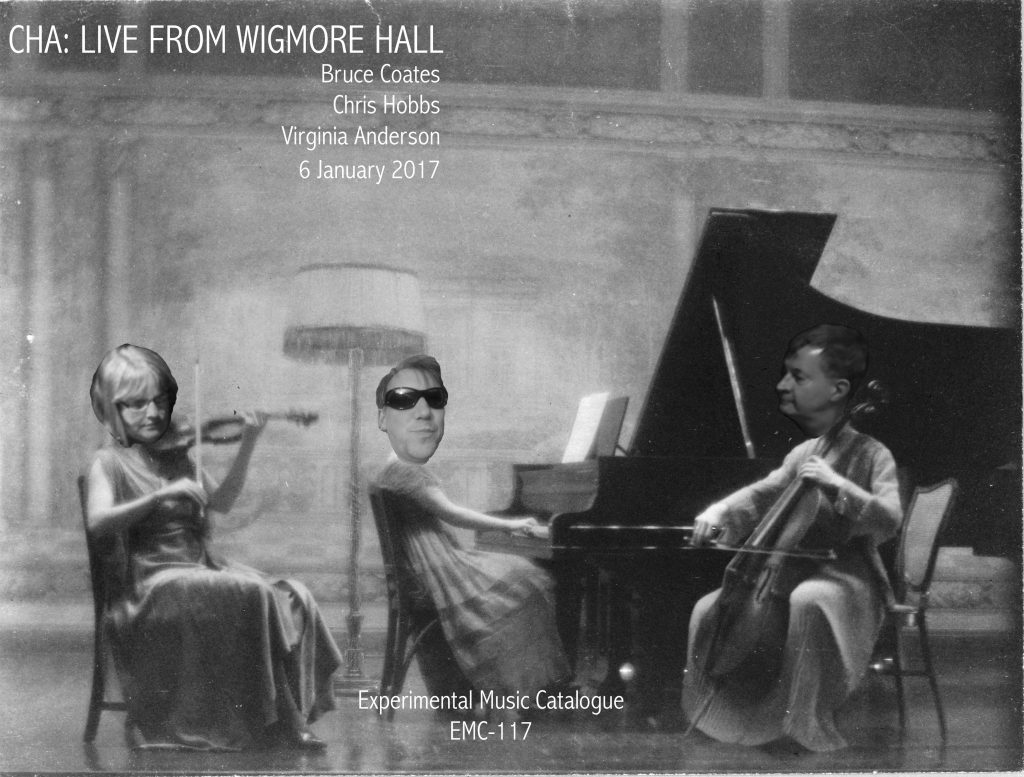
One of the most gratifying features of being on the Experimental Music Catalogue staff, and of researching British and West Coast American free improvisatory, experimental, minimal, and postminimal music, is that it is often so fun, due to an aesthetic criteria that I have described elsewhere as “humour as a noble emotion.” Instead of thinking that all good music must be weighty, scientific, made for the ages, a lot of these composers and performers, well, like to have a good laugh and use their full talents and experience to write top-quality music that is funny.
And the newest release on EMC Bandcamp from CHA (an acronym standing for Bruce COATES, Chris HOBBS, and me, Virginia ANDERSON)—CHA: Live from Wigmore Hall—began as a bit of banter. A couple of years ago, Chris Hobbs and I were driving along small country roads around Shropshire and Herefordshire, when we spotted a village sign reading “Wigmore”. Chris said, “I wonder if they have a village hall. We could play there and bill it as ‘Live from Wigmore Hall’!” This was quite a giggle: for anyone concerned with music in Britain, London’s Wigmore Hall is perhaps the premiere venue for chamber music in Britain . Built at the turn of the last century, it features stunning acoustics and hosts a weekly concert broadcast live by the BBC. Recordings issued as “Wigmore Hall Live” include works by Mozart, Beethoven, Tippett, Schubert, Britten, Brahms. To think that CHA would perform at such a bastion of classical masterworks was ludicrous. So we kept the idea in mind….
What happened—the recording, the album art, the release—has much to do with the culture of free improvisation and its “personality” and the way that CHA arose and works as a trio.
Music is Painful: The personality of free improvisation
The culture of free improvisation (meaning non-notated, usually non-tonal spontaneous performance by one or more musicians) has always seemed to me to resemble a family reunion. People assemble and interact. They may know each other well and for a long time; it may be their first meeting. Each participant brings in his or her own personality and skills to the meeting. Some players may interact with each other at their first meeting as if they had known each other their whole lives. Other players need to work with each other, to sound each other out, before they find their mix. Some players are like the favourite uncle, full of witty banter and jolly games. Some players—the free spirits—may make musical contributions that are spiritual, philosophical, or arcane (the pioneering group AMM, whose name is an acronym that is secret, has always cultivated an aura of mystery). Some players resemble an unpleasant second cousin, loudly and continuously braying out their prejudices, so that no one else can make conversation (such as the player who brought his homemade fretless bass to improvisations to make ceaseless unmusical booms). Then there are the serious souls, depicting the angst of the world both physically through their contorted bodies, and sonically. For them, improvisation is a serious business, and music is painful.
However, deep personal expression of angst is only one emotional affect that can be delivered through musical improvisation. The late Lol Coxhill was a particularly versatile performer of all sorts of free improvisation, jazz, indie popular music, and musical theatre, much of it full of delight rather than pain, and some of it laugh-out-loud funny. The Art Ensemble of Chicago, billing their concerts as “Great Black Music—Ancient to the Future” presented a panoply of styles and moods that changed from concert to concert. As one of the most “experimental” of Afrocentric bands, their use of toys, and Lester Bowie’s “scientific” experiments are perhaps closest to the experimental music in Britain that we enjoy here at the EMC. Bowie wore a white lab coat on Art Ensemble performances—a clear symbol of his role as “experimenter”. And Bowie’s exploration and ennoblement of the mundane, even tacky, corners of popular music reminds me of that great founding experimentalist, Erik Satie. His absolutely delightful album Fast Last! (1974), one of his non-Art Ensemble projects, mixed the track “F Troop Rides Again”, a meditation on the theme of one of the silliest of 1960s American comedy series, with the Broadway standard “Hello Dolly” and “Lonely Woman”, a haunting piece by Ornette Coleman. This equality of the deeply silly, the old standard, and the complex classic is reminiscent of much British experimental music since the late 1960s, especially the music of John White (whose titles and pieces can be simultaneously deep and silly), and it may lie in the deep subconscious of CHA improvisation. That is, if CHA, a spontaneous ensemble, actually stopped to think of it.
CHA: The Road to Wigmore
What CHA did think about was how to set up the joke. I found that, yes, indeed, there was a village hall at Wigmore that could be hired. So we booked a couple hours at the hall for 6 January and, on a day of flooding and pouring rain, Chris, Bruce and I met at the Village Hall. We brought our instruments, sound objects, toys and other materials. We also brought a picnic hamper filled with meat and cheese sandwiches on rye and a large bottle of Belgian beer.

This Wigmore Hall is more versatile than London’s Wigmore Hall, as it hosts keep-fit classes, meetings, and other events of interest to the villagers.

The decor is also somewhat different to that of the London Wigmore Hall, which is noted for its interior design and acoustics.
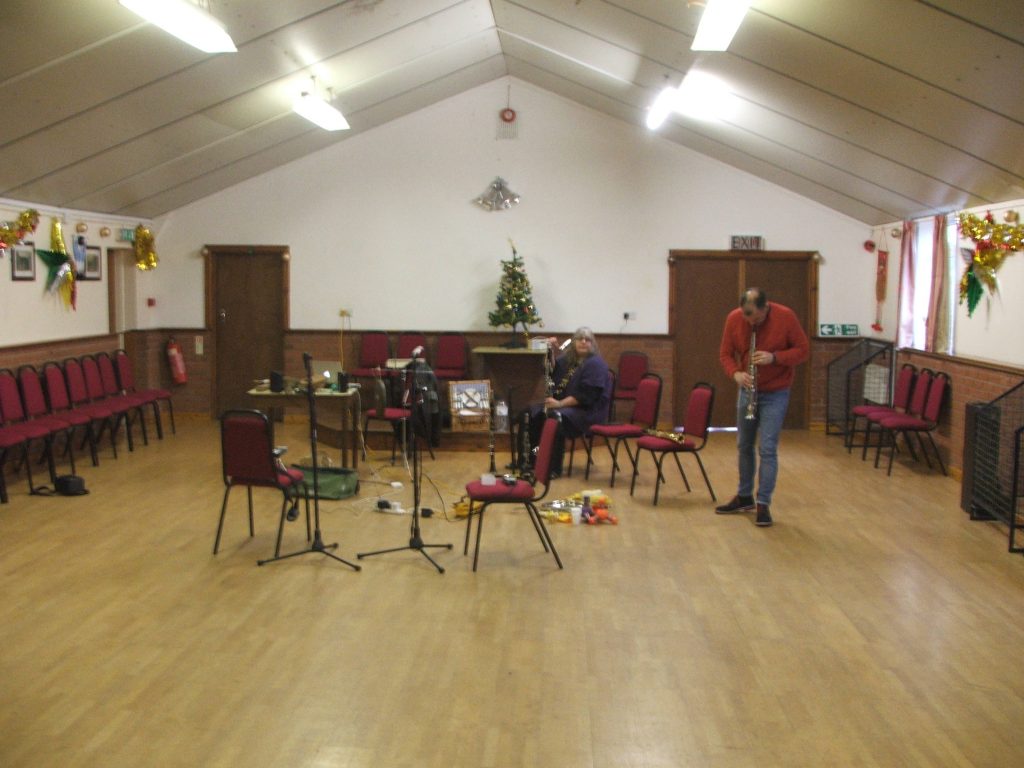
Wigmore Village Hall was decorated when we visited on 6 January with the last of the Christmas decorations. The hall’s acoustics are not bad, though unlike London, the Village Hall has no piano.
The Wigmore Hall recording
Both Chris and Bruce brought portable digital recording devices, recording in WAV format, so that there was a back-up. In the end, we used Bruce’s recording, because Bruce had better microphones. We set up the instruments, which included, for Chris, an Organetta (small reed organ), percussion, laptop with GarageBand loops, some toy noisemakers, and a radio. Bruce brought his saxophones (including a lurid plastic alto) and other sound sources, including dog toys, a metal thali, and comedy rubber animals. I brought three clarinets and stuck mainly to playing them, with only the occasional duck call.
The actual improvisation, which can be heard on the EMC Bandcamp page, is hard to describe in words. Basically, the nature of the instrumentation and the personalities of the trio gives the music a lighter, airier quality that a lot of free improv. There is more space, more short silences that many groups. And it is perhaps less aggressive than the so-called “sync or swarm” improvisation that is more commonly written about. There is a tendency toward a higher tessitura, as Bruce tends to favour his soprano and sopranino saxes, which I often match with my Eb sopranino clarinet. Chris tended to move around the room, to the dais, with its Christmas tree and his Organetta and radio; to the middle of the room, with the laptop and gong; and then carrying small percussion and his pennywhistle toward the entrance at the back of the hall. In the third set, “Consumption”, the combination of the little sax, little clarinet, and Chris’s pennywhistle set up a magnificent subharmonic drone that supported the high sounds, which, like so many subharmonics, was not picked up by the recording. Sometimes the sound world is jagged, but concords, even modality can show up. And of course, there are the toys: rubber chickens and sheep; a strange, squeaking dog toy in the form of a jack.
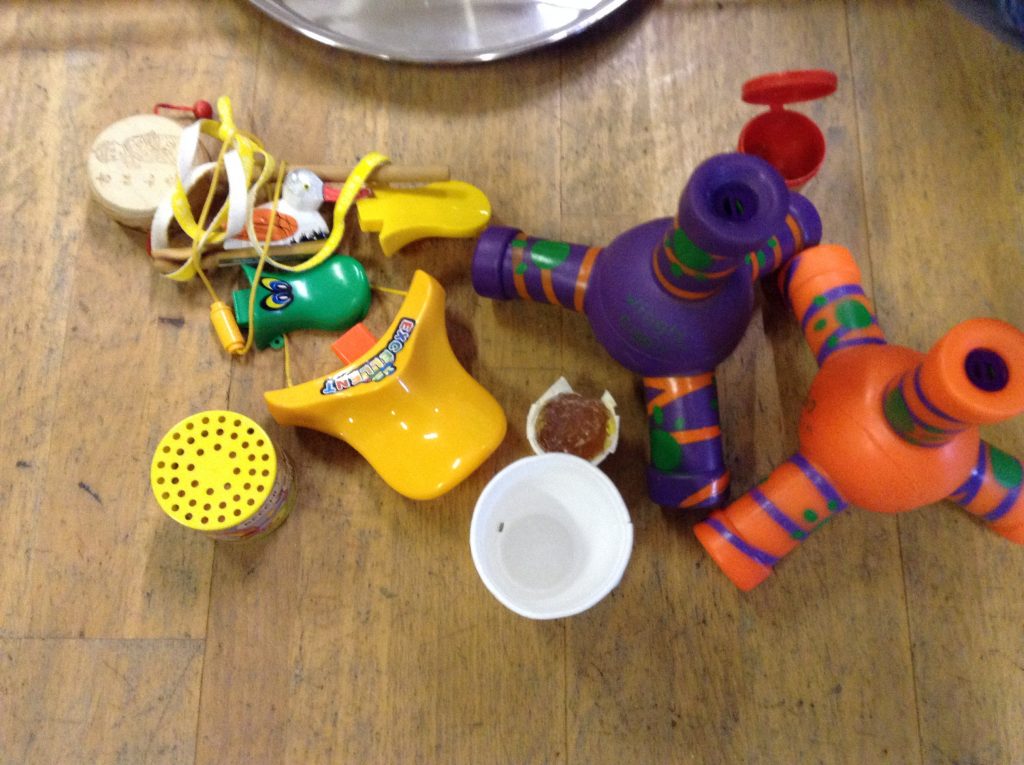
We decided that as much of the actual sounds that the microphones did pick up of the Wigmore Village Hall performance should be included, which is why, at the end of the first set, “Interruption”, a man’s voice can be heard. This “person from Porlock” (as Samuel Taylor Coleridge’s unwelcome visitor came to be known) wished to inform us that he and a couple other people would be using the smaller room of the hall to have a conversation. I pointed to the microphones, said, “We’re recording.” He apologized and exited. The second set, “Resumption”, and third set proceeded without further disruption, as our contented conversation at the end of “Consumption” shows. “Consumption” refers to the contents of the CHA picnic basket.
Producing the album
Bruce invented the titles after the recording and cover art had been made; indeed, after the liner notes were already in a completed draft. Titles for free improvisation tracks are perhaps the most arbitrary of all titles in music. There is no structure in free improvisation that would suggest a generic name like “sonata”; the mood or emotional “affect”, should there be one, often emerges only in real time. Many improvisers choose poetic, often obscure titles, such as “Later During a Flaming Riviera Sunset”, and “Ailantus Glandulosa” on AMM’s AMMmusic (1966). CHA has no such mystical identity: we have been primarily identified by pictures of toys (the small animal heads made by Bruce’s father, the artist Andrew Coates, which graced the promotional material for our 2013 concert at the Engine House, Manchester) or tea cups and mugs (a play on the British slang term for tea, “cha”).

This time, I wanted something that tied in with the Wigmore Hall association, so Bruce designed the cover using a copyright-free image of a piano trio of women from sometime in the 1920s. We saw, we giggled, we waited for someone to counsel for something more momentous to go with our great work for the ages, and when that objection never arose, we released CHA: Live from Wigmore Hall.
CHA, CHA, CHA….
So ends this explanation of the first CHA album. It is always a mistake to explain a joke, but since this was an in-joke between our trio, I thought I would provide some background, not just to the recording, but where it sits as experimental practice among more traditionally-minded modern music. Music does not have to be painful, though of course it can be; music can be pretty—it can be fun. I can’t wait for the next CHA adventure.


